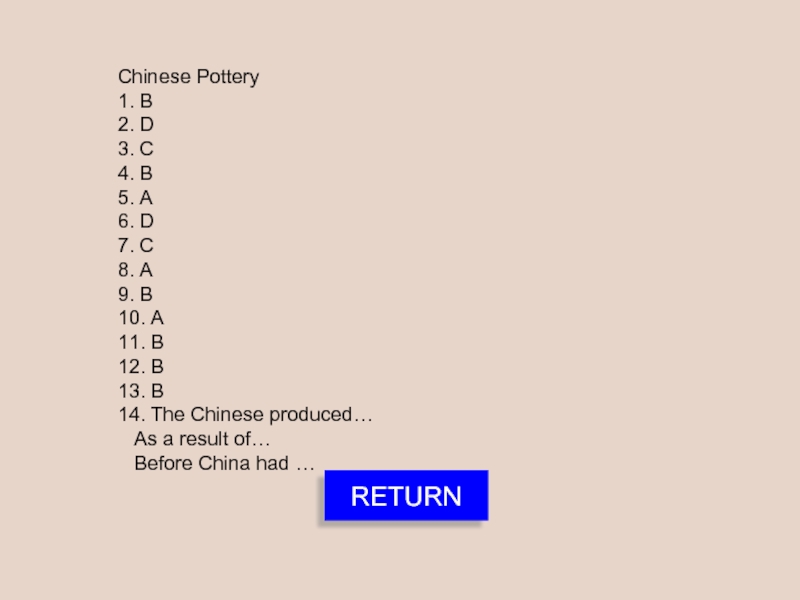- Главная
- Разное
- Дизайн
- Бизнес и предпринимательство
- Аналитика
- Образование
- Развлечения
- Красота и здоровье
- Финансы
- Государство
- Путешествия
- Спорт
- Недвижимость
- Армия
- Графика
- Культурология
- Еда и кулинария
- Лингвистика
- Английский язык
- Астрономия
- Алгебра
- Биология
- География
- Детские презентации
- Информатика
- История
- Литература
- Маркетинг
- Математика
- Медицина
- Менеджмент
- Музыка
- МХК
- Немецкий язык
- ОБЖ
- Обществознание
- Окружающий мир
- Педагогика
- Русский язык
- Технология
- Физика
- Философия
- Химия
- Шаблоны, картинки для презентаций
- Экология
- Экономика
- Юриспруденция
Test TPO 10. Chinese pottery. (Section 1) презентация
Содержание
- 1. Test TPO 10. Chinese pottery. (Section 1)
- 2. Set the timer to “20:00”
- 3. Question 1 of 14
- 4. Question 2 of
- 5. Question 3
- 6. Question 4
- 7. Question 5
- 8. Question 6
- 9. Question 7
- 10. Question 8
- 11. Question 9
- 12. Question 10
- 13. Question 11
- 14. Question 12
- 15. Question 13
- 16. Question 14
- 18. Congratulations! You have completed this practice test.
- 19. Chinese Pottery 1. B 2. D 3.
- 20. Are you sure you want to exit
- 21. Your answers will be saved with the
- 22. OK When your computer asks you if
- 23. OK When your computer asks you if
Слайд 2
Set the timer to “20:00” before doing the test.
If you
Слайд 3
Question 1 of 14
The word 【status】 in the passage is closest
origin
importance
quality
design
Слайд 4
Question 2 of 14
According to paragraph 2, which of the following
The function of ceramics remained the same from dynasty to dynasty.
The use of ceramics as trade objects is better documented than the use of ceramics as ritual objects.
There was little variation in quality for any type of ceramics over time.
Some religious sculptures were made using the earthenware type of ceramics.
Paragraph 2 is marked with ◆
Слайд 5
Question 3 of 14
The word 【evolved】in the passage is closest in
divided
extended
developed
vanished
Слайд 6
Question 4 of 14
Which of the sentences below best expresses the
While stonewares and porcelains are found throughout most historical periods, religious sculpture is limited to the ancient period.
Religious sculpture was created in most periods, but its history is less clear than that of stonewares or porcelains because some old forms continued to be used even when new ones were developed.
While stonewares and porcelains changed throughout history, religious sculpture remained uniform in form and use.
The historical development of religious sculpture is relatively unclear because religious sculptures sometimes resemble earthenware architectural ornaments.
Слайд 7
Question 5 of 14
Paragraph 3 supports all of the following concerning
The earliest high-fired ceramics were of poor quality.
Ceramics produced during the Tang and Ming dynasties sometimes incorporated multiple colors.
Earthenware ceramics were produced in China before stonewares were.
The Song dynasty period was notable for the production of high quality porcelain ceramics.
Paragraph 3 is marked with ◆
Слайд 8
Question 6 of 14
The word 【instigated】in the passage is closest in
Improved
investigated
narrowed
caused
Слайд 9
Question 7 of 13
According to paragraph 4, one consequence of the
the transfer of a distinctive blue pigment from China to the Middle East
an immediate change from earthenware production to porcelain production in European countries
Chinese production of wares made for the European market
a decreased number of porcelain vessels available on the European market
Paragraph 4 is marked with ◆
Слайд 10
Question 8 of 14
The word 【whereas】in the passage is closest in
while
previously
surprisingly
because
Слайд 11
Question 9 of 14
In paragraph 5, the author compares the designs
emphasize that while Chinese pots were decorative. Greek pots were functional
argue that the designs on Chinese pots had specific meanings and were not just decorative
argue that twentieth-century scholars are better able to understand these designs than were ancient scholars
explain how scholars have identified the meaning of specific images on Chinese pots
Paragraph 5 is marked with ◆
Слайд 12
Question 10 of 14
Which of the following is mentioned in paragraph
Chinese rulers
love of homeland
loyalty to friends
success in trade
Paragraph 5 is marked with ◆
Слайд 13
Question 11 of 14
Paragraph 5 suggests which of the following about
They had more importance for aristocrats than for ordinary citizens.
Their significance may have remained clear had the Chinese not come under foreign influence.
They contain some of the same images that appear on Greek pots
Their significance is now as clear to twentieth-century observers as it was to the early Chinese.
Paragraph 5 is marked with ◆
Слайд 14
Question 12 of 14
The word 【these】in the passage refers to
religious ceremonies
descriptions
types of ware
pots
Слайд 15
Question 13 of 14
Look at the four squares [■]that indicate where
Foreign trade was also responsible for certain innovations in coloring.
Where would the sentence best fit?
■ 1
■ 2
■ 3
■ 4
Слайд 16
Question 14 of 14
Directions: An introductory sentence for a brief summary
Answer Choices
To review passage. Click View Text
Ceramics have been produced in China for a very long time.
●
●
●
The Chinese produced earthenware, stoneware, and porcelain pottery, and they used their ceramics for a variety of utilitarian, architectural, and ceremonial purposes.
As a result of trade relations. Chinese ceramic production changed, and Chinese ceramics influenced the ceramic production of other countries.
Before China had contact with the West, the meaning of various designs used to decorate Chinese ceramics was well understood.
The shape and decoration of ceramics produced for religious use in China were influenced by Chinese ceramics produced for export.
Chinese burial ceramics have the longest and most varied history of production and were frequently decorated with written texts that help scholars date them.
Ceramics made in imperial factories were used in both religious and non-religious contexts.
Слайд 18Congratulations!
You have completed this practice test.
Save / exit the test
Review
Obtain answer keys
Слайд 19Chinese Pottery
1. B
2. D
3. C
4. B
5. A
6. D
7. C
8. A
9. B
10.
11. B
12. B
13. B
14. The Chinese produced…
As a result of…
Before China had …
RETURN
Слайд 20Are you sure you want to exit the test?
YES
NO
Exit the test.
Return to the last question and resume doing the test.
Слайд 21Your answers will be saved with the file.
Your answers will
Do you want to save your answers?
YES
NO



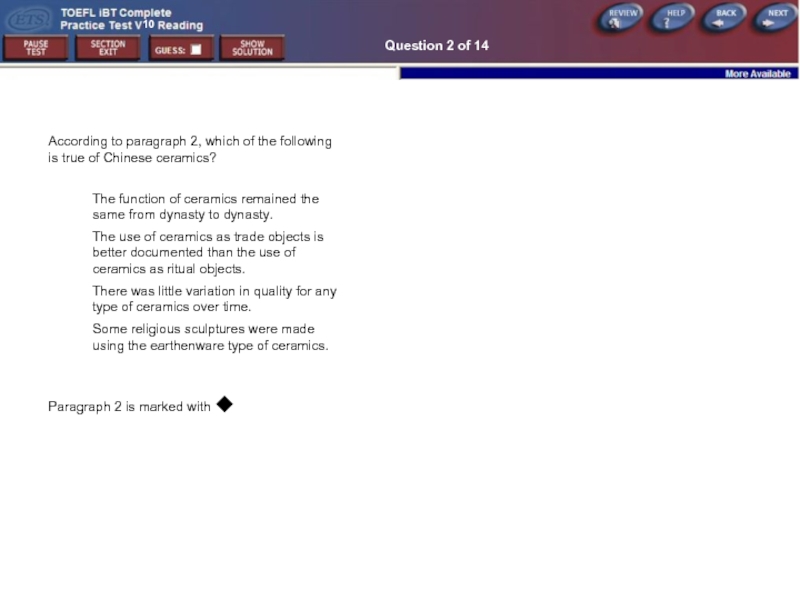

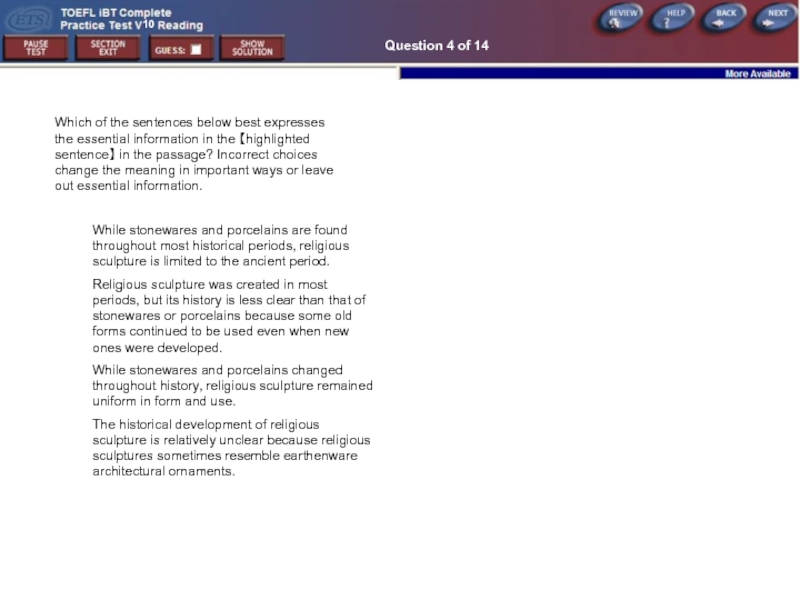
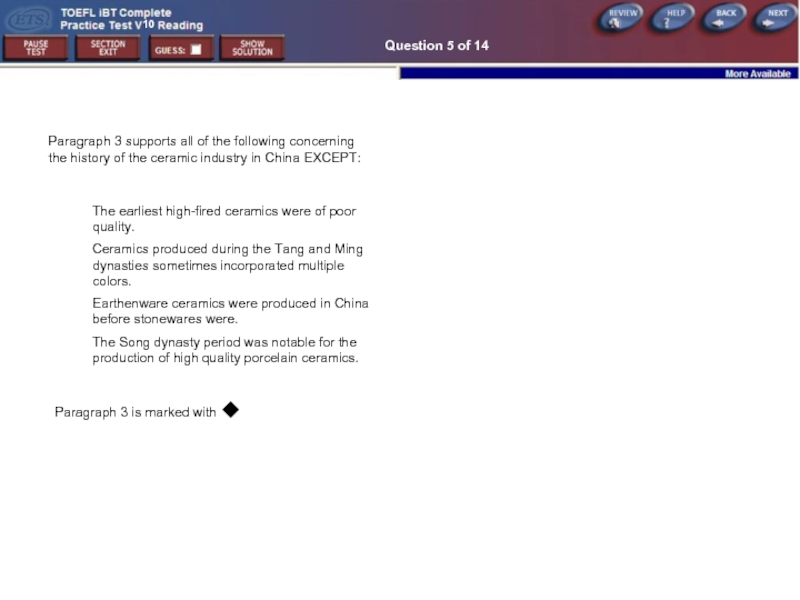



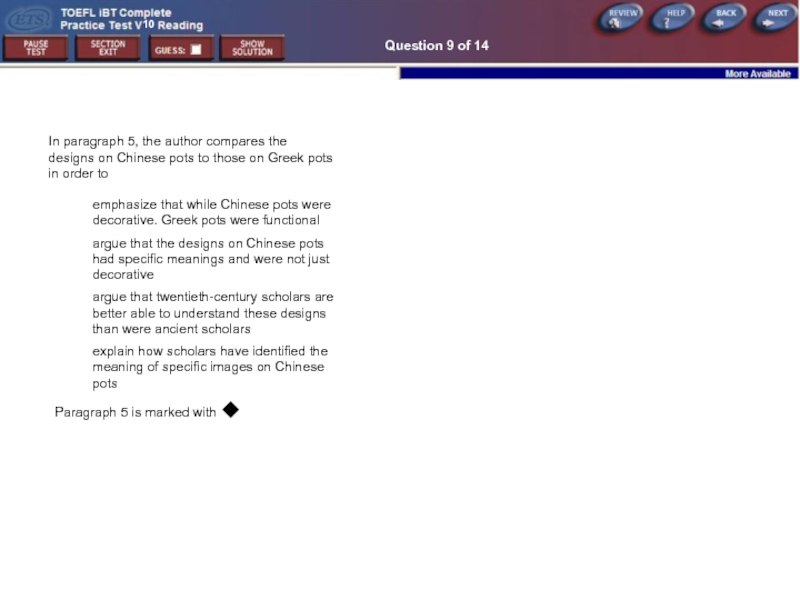
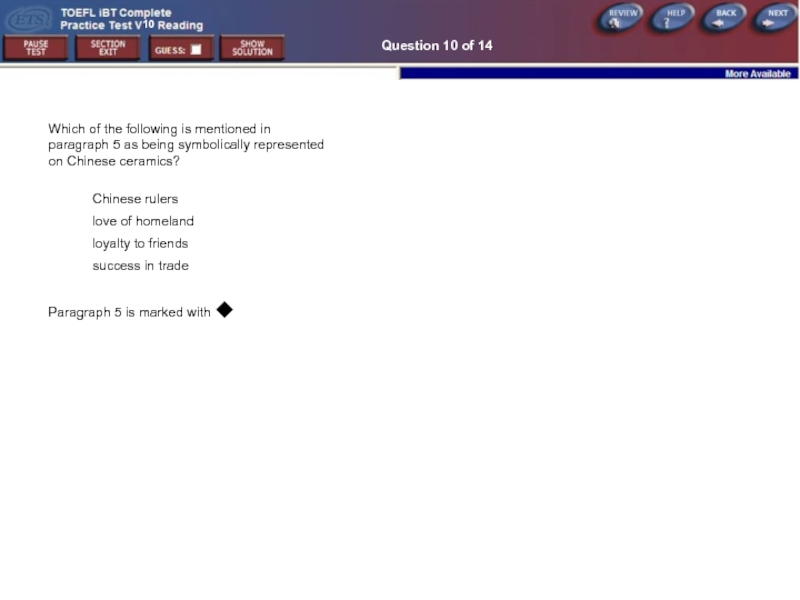
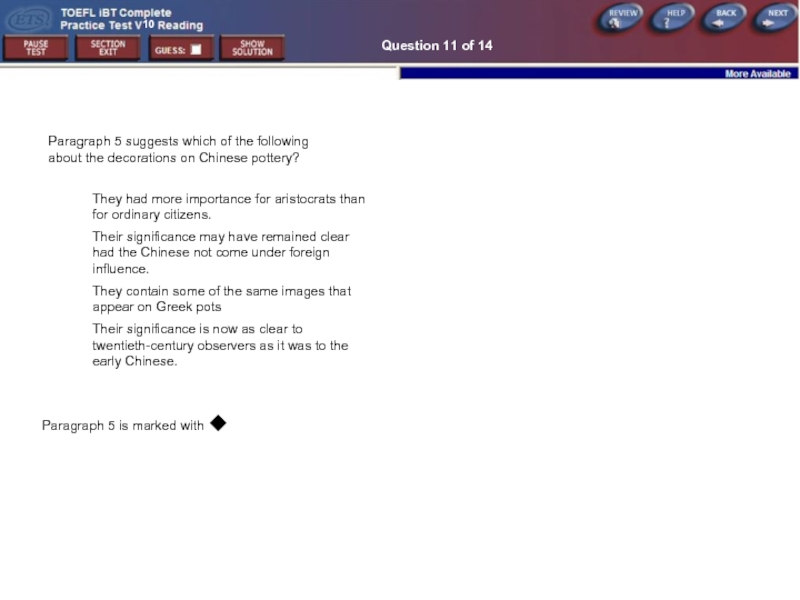

![Question 13 of 14Look at the four squares [■]that indicate where the following sentence could](/img/tmb/1/9339/6eb4ca9c4cfa49342978865a2d6fead2-800x.jpg)



